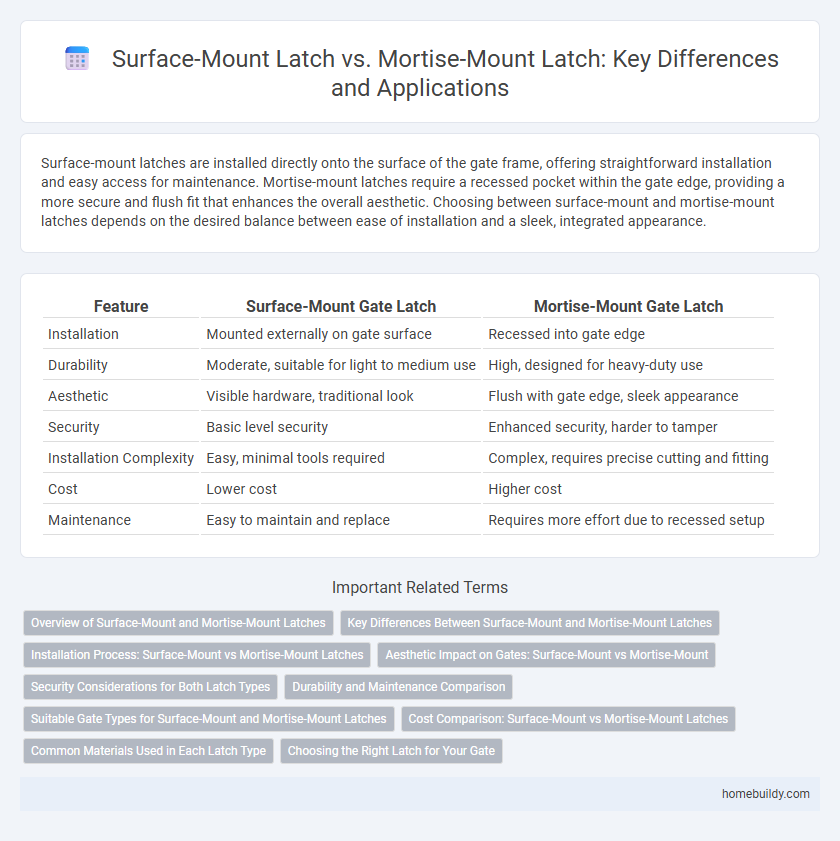Surface-mount latches are installed directly onto the surface of the gate frame, offering straightforward installation and easy access for maintenance. Mortise-mount latches require a recessed pocket within the gate edge, providing a more secure and flush fit that enhances the overall aesthetic. Choosing between surface-mount and mortise-mount latches depends on the desired balance between ease of installation and a sleek, integrated appearance.
Table of Comparison
| Feature | Surface-Mount Gate Latch | Mortise-Mount Gate Latch |
|---|---|---|
| Installation | Mounted externally on gate surface | Recessed into gate edge |
| Durability | Moderate, suitable for light to medium use | High, designed for heavy-duty use |
| Aesthetic | Visible hardware, traditional look | Flush with gate edge, sleek appearance |
| Security | Basic level security | Enhanced security, harder to tamper |
| Installation Complexity | Easy, minimal tools required | Complex, requires precise cutting and fitting |
| Cost | Lower cost | Higher cost |
| Maintenance | Easy to maintain and replace | Requires more effort due to recessed setup |
Overview of Surface-Mount and Mortise-Mount Latches
Surface-mount latches attach directly to the door or gate surface, offering easier installation and compatibility with lighter gates, whereas mortise-mount latches fit into a recessed cutout, providing a more secure and aesthetically integrated solution for heavy-duty gates. Surface-mount options often feature adjustable strike plates and simpler maintenance, while mortise latches afford increased durability and resistance to forced entry due to their embedded design. Both latch types play crucial roles in gate hardware, catering to different security needs and installation preferences.
Key Differences Between Surface-Mount and Mortise-Mount Latches
Surface-mount latches attach directly to the gate's surface, requiring minimal installation effort and preserving the gate's structural integrity, while mortise-mount latches are recessed into the gate edge, providing a cleaner appearance and enhanced security. Surface-mount latches are typically easier to replace or adjust, making them ideal for lighter gates and temporary setups, whereas mortise-mount latches are favored for heavy-duty gates that demand durability and tamper resistance. The choice between these two depends on the balance of installation complexity, aesthetic preference, and security requirements for the gate system.
Installation Process: Surface-Mount vs Mortise-Mount Latches
Surface-mount latches install externally on the gate surface, requiring minimal tools and no door modification, making the process quicker and easier. Mortise-mount latches require precise recess cutting into the gate edge, demanding more skill and time for proper alignment and secure fit. Surface-mount installation is ideal for retrofit projects, while mortise-mount offers a more integrated and stronger locking mechanism.
Aesthetic Impact on Gates: Surface-Mount vs Mortise-Mount
Surface-mount latches offer a visible installation that can enhance rustic or industrial gate designs through their exposed hardware, adding character and texture. Mortise-mount latches are embedded into the gate edge, creating a sleek, seamless appearance ideal for modern or minimalist aesthetics. Choosing between surface-mount and mortise-mount latches significantly influences the gate's overall visual integration with surrounding architecture and landscape design.
Security Considerations for Both Latch Types
Surface-mount latches offer straightforward installation but may be more vulnerable to forced entry due to their external positioning, making them less ideal for high-security applications. Mortise-mount latches are embedded within the gate frame, providing enhanced resistance against tampering and greater structural integrity, thus offering superior security benefits. Choosing between the two depends on balancing installation ease with the level of protection required for the specific gate environment.
Durability and Maintenance Comparison
Surface-mount gate latches offer easier installation and quicker access for maintenance but typically exhibit lower durability due to exposure to external elements and potential wear on mounting surfaces. Mortise-mount latches, embedded within the gate structure, provide superior durability by protecting internal mechanisms from weather and physical damage, resulting in less frequent maintenance requirements. Choosing between the two depends on the balance between ease of upkeep and the need for a robust, long-lasting latch solution.
Suitable Gate Types for Surface-Mount and Mortise-Mount Latches
Surface-mount latches are ideal for lightweight or ornamental gates made from aluminum or tubular steel, offering easy installation without extensive modifications. Mortise-mount latches suit heavy-duty or wooden gates requiring a flush, secure fit, as they are recessed into the gate for enhanced durability and aesthetic integration. Selecting the appropriate latch type depends on gate material, thickness, and desired security level to ensure optimal performance.
Cost Comparison: Surface-Mount vs Mortise-Mount Latches
Surface-mount latches typically offer lower installation costs due to their simpler mounting process and minimal door modification requirements. Mortise-mount latches involve higher labor expenses because they require precise door cavity cutting and specialized tools. Material costs for both types vary, but surface-mount latches generally present a more budget-friendly option for standard gate applications.
Common Materials Used in Each Latch Type
Surface-mount gate latches are commonly constructed from stainless steel, aluminum, and zinc alloy, offering corrosion resistance and ease of installation on door surfaces. Mortise-mount latches typically utilize brass, bronze, or heavy-duty steel, providing enhanced durability and security by being embedded within the gate frame. Both latch types may feature protective coatings such as powder coating or galvanization to extend lifespan in outdoor environments.
Choosing the Right Latch for Your Gate
Surface-mount latches are easier to install and ideal for gates with flat surfaces, offering convenience and minimal tools required. Mortise-mount latches require precise cutouts within the gate material, providing a more secure and flush fit for heavy-duty or high-traffic gates. Selecting the right latch depends on gate material, usage frequency, and security needs, ensuring durability and optimal functionality.
surface-mount latch vs mortise-mount latch Infographic

 homebuildy.com
homebuildy.com